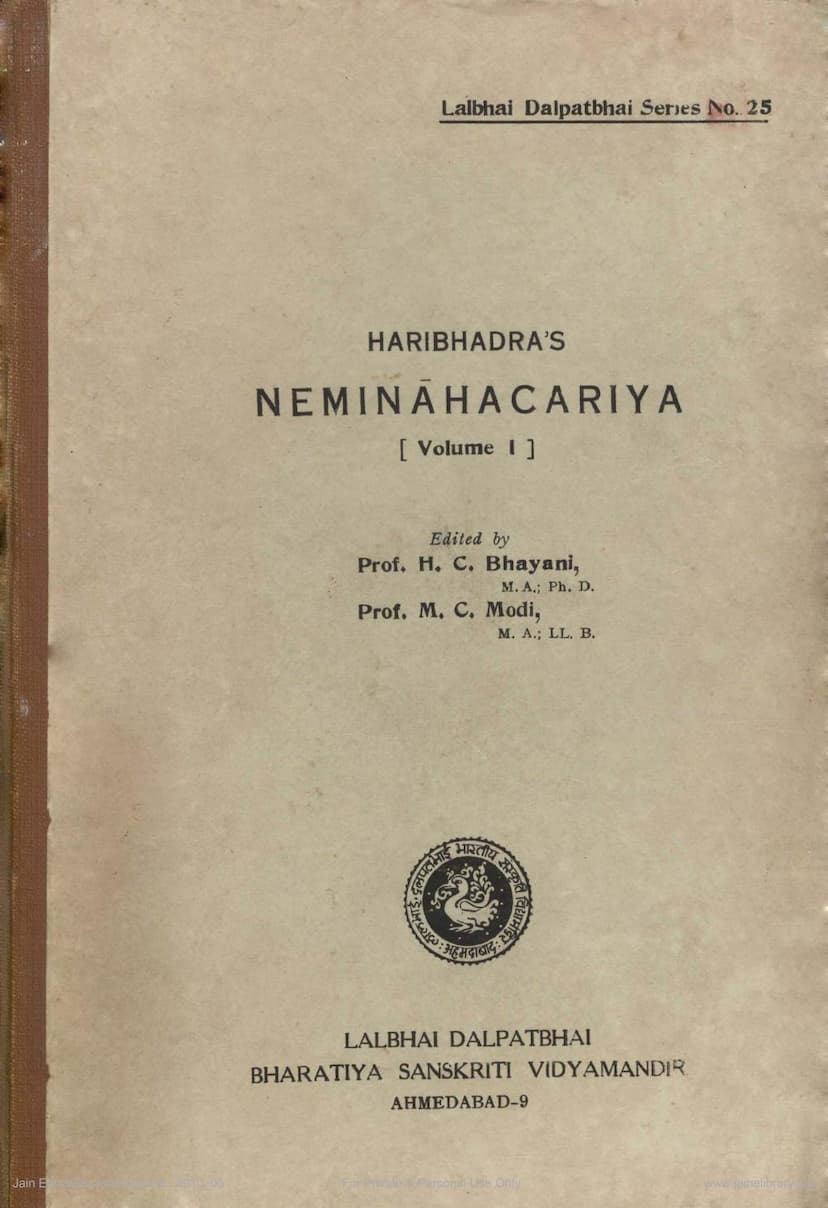Neminahacariya Part 1
Added to library: September 2, 2025

Summary
Here's a comprehensive summary of Haribhadrasuri's Neminahacariya, Volume 1, based on the provided text:
Title: Haribhadra's Nemināhacariya, Volume 1 Authors: Haribhadrasuri, edited by Prof. H. C. Bhayani and Prof. M. C. Modi Publisher: L D Indology, Ahmedabad Publication Date: August 1970
Overview: This volume presents the first installment of the Apabhramśa epic poem Nemināhacariya (Sanskrit: Nemināthacarita), which narrates the mythological life of Neminātha, the 22nd Tirthamkara of the Jainas. Composed in V.S. 1216 (1160 A.D.) by Haribhadrasuri, a disciple of Śricandrasuri, the work is published here in its entirety for the first time. The preface highlights its significance as a highly important work of Apabhramśa literature due to several unique features.
Key Features and Significance:
- Apabhramśa Epic: The Nemināhacariya is an Apabhramśa poem of epic proportions. Its study is crucial for understanding the development of modern Indian regional languages and for appreciating the metrical experiments and poetic charm of Apabhramśa writers.
- Svetāmbara Jain Literature: It is one of only two known Apabhramśa poems of epic length attributed to a Śvetāmbara author, the other being Sadhāraṇa's Vilasavaiha (composed in 1066 A.D.). All other major Apabhramśa epics published to date are Digambara Jain works.
- Composition Location: The poem was composed in Anahillapura (modern Patan), the capital of the Caulukyas of Gujarat.
- Manuscript Preservation: It is preserved in an old palm-leaf manuscript, which is considered a valuable asset as most other available Apabhramśa works are found in paper manuscripts.
- Metrical Structure: The poem primarily employs the "Raddā" meter. Haribhadrasuri uses Raddā in a "Pañcapadī" (five-lined) form, deviating from the usual nine-lined structure. He treats sections of the Mātrā and Doha meters as single units, creating a unique metrical pattern. The edition arranges the lines to conform to the nine-line view for better variant noting and clarity of structure.
- Voluminous Work: The poem is substantial, containing over 8,000 verses. This first volume covers the story of the first eight Bhavas (existences or lives) of Neminātha's life. Subsequent volumes will complete the text and include a general introduction, linguistic analysis, and glossary.
Content of Volume 1 (First Eight Bhavas):
The volume begins with traditional invocations to Tirthamkaras, including Rishabhanatha and Mahavir, and then pays homage to Haribhadrasuri's lineage of gurus, including Śricandrasūri. The narrative then unfolds, detailing the events of Neminātha's previous lives and his earthly existence.
- Chapter 1 (Pathama Bhava - Dhanavṛttānta): This section focuses on the story of Dhana, the first life that leads to Neminātha's eventual Tirthamkarahood. It describes the lineage of King Vikrama, his minister Sumati, and their aspirations. The narrative details the birth of Dhana, his wealthy upbringing, and his father Anand's wish for a son. It recounts Dhana's marriage to Padmavati and the subsequent events leading to his renunciation and spiritual journey.
- The text continues through subsequent Bhavas, detailing Neminātha's previous lives and the various actions and circumstances that shaped his spiritual progression. These include the stories of:
- Second Bhava: Likely continuing the narrative of previous lives.
- Third Bhava (Chitragati Vṛttānta): The story of Chitragati.
- Fourth Bhava: Likely continuing the narrative.
- Fifth Bhava (Aparajita Vṛttānta): The story of Aparajita.
- Sixth Bhava: Likely continuing the narrative.
- Seventh Bhava (Śānka Vṛttānta): The story of Śānka.
- Eighth Bhava: Likely continuing the narrative.
The early sections of the text (starting from stanza 11) describe the city of Ayodhyā and its ruler, King Vikrama, his minister Sumati, and the birth of their son, Dhana. The narrative describes the prophecy of Dhana becoming a great soul, his virtuous character, and the initial stages of his life, including his marriage. The text also touches upon the worldly pleasures and eventual renunciation that mark the path towards spiritual liberation.
Editorial and Publishing Details:
- The edition is based primarily on a valuable palm-leaf manuscript from the Jinabhadragaṇi Jñānabhaṇḍār at Jesulmere.
- A paper manuscript from the Vijayadevasuri's Collection at the L. D. Institute of Indology was also consulted for orthographical variants.
- The editors acknowledge the assistance of various individuals and institutions, including Muni Shri Punyavijayaji and Prof. Dalsukh Malvania, for their support in securing manuscripts and facilitating publication.
- The publication aims to be of great value to students of Apabhramsa language and literature.
Overall: Nemināhacariya, Volume 1, is a significant scholarly undertaking, making a crucial Apabhramśa epic poem accessible to a wider audience. It provides valuable insights into Jain mythology, Apabhramśa literature, language, and prosody, offering a rich narrative of the spiritual journey leading to Neminātha's enlightenment.